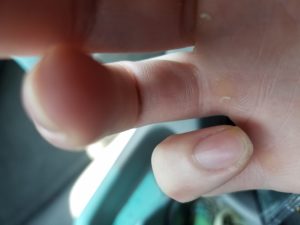Tubacin is not over the counter but you can buy it but it’s for lab research only so there’s no guarantee that it’ll work and we don’t know if there’s side effects. “Tubacin is a highly potent and selective, reversible, cell-permeable HDAC6 inhibitor with an IC50 of 4 nM in a cell-free assay, approximately 350-fold selectivity over HDAC1.”
HDAC6 deficiency or inhibition blocks FGFR3 accumulation and improves bone growth in a model of achondroplasia.
“Mutations that cause increased and/or inappropriate activation of FGFR3 are responsible for a collection of short-limbed chondrodysplasias. These mutations can alter receptor trafficking and enhance receptor stability, leading to increased receptor accumulation and activity. wildtype and mutant activated forms of FGFR3 increase expression of the cytoplasmic deacetylase HDAC6 (Histone Deacetylase 6) and that FGFR3 accumulation is compromised in cells lacking HDAC6 or following treatment of fibroblasts or chondrocytes with small molecule inhibitors of HDAC6. The reduced accumulation of FGFR3 was linked to increased FGFR3 degradation that occurred through a lysosome-dependent mechanism. Using a mouse model of Thanatophoric Dysplasia Type II (TDII) we show that both HDAC6 deletion and treatment with the small molecule HDAC6 inhibitor tubacin reduced FGFR3 accumulation in the growth plate and improved endochondral bone growth. Defective endochondral growth in TDII is associated with reduced proliferation and poor hypertrophic differentiation and the improved bone growth was associated with increased chondrocyte proliferation and expansion of the differentiation compartment within the growth plate.”
“The effects of activating FGFR3 mutations on growth plate chondrocytes are mediated by the activation or modulation of several interconnected downstream signaling programs, including the MAPK, BMP and Hedgehog pathways. These pathways converge on key downstream targets such as STAT, SMAD, Snail and Sox9 transcription factors that play important roles in chondrocyte proliferation, differentiation and survival”
“HDAC6 controls FGFR3 accumulation by regulating its protein stability and that tubacin-dependent destabilization of FGFR3 is more robust in chondrocytes than in MEFs.”
“the absence of HDAC6 resulted in modest increases in tibia and femur OB length, but not in ulna or humerus”
” since HDAC6 regulates FGFR3 accumulation, increased HDAC6 might trigger a positive feedback system whereby HDAC6 and FGFR3 promote and maintain each other’s expression. Elevated FGFR3 in this scenario is predicted to behave analogously to mutant versions of FGFR3 and have a negative effect on both chondrocyte proliferation and differentiation. In addition or alternatively, elevated HDAC6 in achondrodysplasia-related disorders might contribute to disease by deacetylation of proteins such as α−Tubulin and Cortactin which can alter cell mobility and adhesion ”
Requirement of HDAC6 for activation of Notch1 by TGF-β1.
“TGF-β1 is enriched in the tumor microenvironment and acts as a key inducer of epithelial to mesenchymal transition (EMT) {Mesenchymal to Epithelial translation may be a key growth plate stage but knowledge of the reverse may be important to our understanding} in lung cancer. The NOTCH signaling pathway is conserved across species and is an essential pathway for development, cell differentiation, and cancer biology. Dysregulation of Notch signaling is a common feature of non-small cell lung cancer (NSCLC) and is correlated with poor prognosis. Crosstalk exists between the NOTCH and TGF-β signaling pathways in EMT. Herein we report that histone deacetylase 6 (HDAC6) modulates TGF-β1-mediated activation of the Notch pathway. HDAC6, a primarily cytoplasmic deacetylase, mediates TGF-β1-induced EMT in human lung cancer cells. Inhibition of HDAC6 with a small molecule inhibitor, namely tubacin or with siRNA attenuated TGF-β1-induced Notch-1 signaling. We show that TGFβ-1-induced EMT is accompanied by rapid HDAC6-dependent deacetylation of heat shock protein 90 (HSP90). Consistently, inhibition of HSP90 with its small molecule inhibitor 17AAG attenuated expression of TGF-β1-induced Notch-1 target genes, HEY-1 and HES-1. These findings reveal a novel function of HDAC6 in EMT via mediating the TGF-β-Notch signaling cascade, and support HDAC6 as a key regulator of TGFβ-induced EMT in NSCLC.”
“Epithelial-mesenchymal transition (EMT) is a process in which epithelial cells lose their characteristic cell-cell junctions and polarization of cell-surface molecules while acquiring properties typical of mesenchymal cells”








